What is origami and what is it like?

Surely every person in childhood collected origami figures from paper, for example, a dragon, an airplane or a boat. These most common types of paper crafts are just a tiny part of the origami technique, because in fact, this art contains a rich history and many different ways to create beautiful things with your own hands. In this article, we will take a closer look at what origami is, how it appeared and how it happens.



What it is?
Origami is a technique for creating figures from paper, literally from Japanese this definition is translated as "folded paper". The art of folding paper crafts appeared in the East, gradually spreading throughout the world. Paper crafts are versatile, as the most popular figurines require nothing but paper and inspiration.
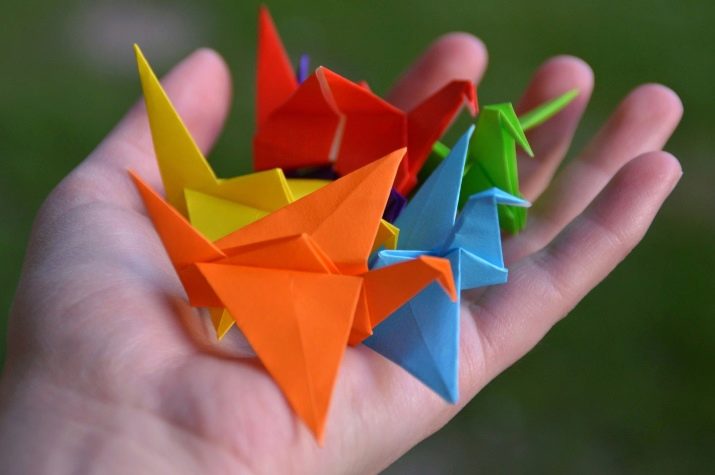
Japanese origami is based on folding, folding and unfolding sheets of paper in a specific way. There are several types of arts and crafts, differing in the amount of materials used and folding technique. Beginner origami folks fold classic figures without the use of scissors and glue. Experienced needlewomen will also find interesting techniques for folding classic origami, because there are a huge number of schemes of different levels of complexity.


The most difficult are wet and modular folding techniques, which are usually handled by more experienced craft lovers.
History of origin
The arts and crafts of paper folding appeared centuries ago, so there are many theories about its origins. Most of them agree that origami is home to Japan. The reason for this opinion is that the Japanese already in the XII century actively used this art for various religious rituals - crafts were often hung at the entrance to temples and installed at home on altars.
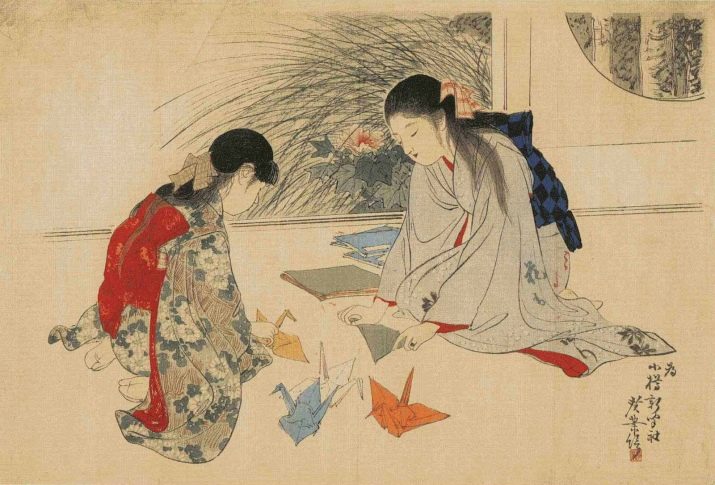
To this day, Japan has retained some origami folding traditions and popular beliefs, such as folding thousands of cranes to make a wish or placing a kusudama ball at the head of the bed to attract good dreams.
The first origami were made from silkworm caterpillar cocoons. First, a sufficient number of cocoons were collected, boiled in water and dried. The material was then ironed to create a thin, silky sheet reminiscent of modern paper. Such a product was not cheap, so over time it was replaced with paper made from bamboo and tree bark.



In addition to Japan, art has been actively developing in other countries such as China, Korea, Spain and Germany. In Europe, origami began to enjoy popularity a little later than in Eastern countries - the Spaniards began to conduct ceremonies using paper crafts around the 15th century. The biggest jump in the popularity of arts and crafts came at a time when German educator Friedrich Froebel proposed adding it to the educational program for preschoolers.

In the middle of the 20th century, the Yoshizawa-Randlett notation system was introduced into use, this significantly improved the understanding of schemes and allowed art to spread throughout the world. Around the 1960s, people began to massively create not only classic figurines, but also voluminous modular paper crafts. Nowadays, origami is considered one of the most widespread hobbies in the world, and also an excellent way to develop fine motor skills of hands.

Description of species
Classic origami involves creating figures from a single sheet of paper. Most often, such crafts are flat, but there are also unusual mobile and incredibly complex products. This type of arts and crafts is the most common, but it includes many basic forms and difficult patterns that beginners should not get started with.



For this reason, there are simplified systems for making crafts and fundamentally different techniques.
The following types are considered to be varieties of origami: assembling from modules, simple bending techniques, making crafts according to a pattern and creating figures with smooth shapes using wet folding. Despite all the differences, each species uses a universal notation system invented by the Japanese origami master Akira Yoshizawa. We suggest taking a closer look at each type of arts and crafts.




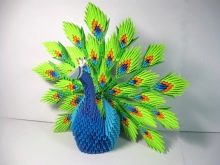
Modular
In modular origami, the folding technique is the same as in classic origami, but the result of the work is significantly different. Modular crafts - these are large figures assembled from a large number of folded paper modules... Each module is created using the same technology, and then all the parts are folded into each other in a certain way to obtain a product of the required shape. In some crafts, the size of the parts may differ, but the principle of folding the modules is always the same.






Small simple structures do not disintegrate due to friction, and glue is sometimes used to secure complex heavy models, but this is not necessary.
The modules themselves are also of different types, but for each specific craft, only one folding scheme is used. There is also a modular origami technique, in which it is impossible to do without glue, for example, when making a kusudama ball. Simple crafts, such as a Sonobe cube or a small flat panel, hold firmly and without glue. In the event that a panel or figure has hundreds or even thousands of modules, glue becomes necessary.



The types of modules differ in the way they are connected to each other, as a result, from each type of parts, a huge assortment of various crafts is obtained. Details are both flat and volumetric: the first are polygons (stands), stars, rings and spinners, and the second are regular polyhedra and their combinations.





Simple
A simple technique for folding paper figures was invented by a Briton named John Smith. A British origamiist invented a simplified origami-making system designed for beginner craftsmen, based solely on mountain and valley folds. Simple origami is suitable not only for inexperienced origamiists, but also for people with disabilities.

The rigid framework of only two folding techniques makes it impossible to use complex techniques (with some exceptions), but at the same time inspires to come up with new schemes that lead to a similar result.
The simple origami technique is to create a figurine with basic distinctive features, but using a minimum of folds and folds. Another difference between simple origami and classic origami is the absence of strict requirements for correct folds, all folds are made "by eye". This reveals additional advantages when creating crafts, because each product will be unique, especially if it is an animal's face or a person's facial expression.





Folding according to the pattern
An origami pattern is a special drawing on which all the necessary folds are already applied to fold the craft. This technique is more convenient than drawing up a conventional diagram, because the instruction will be too cumbersome for complex shapes. Nowadays, simplified pattern diagrams are used to reproduce incredibly complex patterns, so such Japanese arts and crafts are becoming more and more popular.



At first glance, it may seem that the pattern is not as descriptive as the standard origami assembly diagram. However, in fact, the drawing provides a lot of information - not only instructions for folding the model, but also how it was invented.... American origamist Robert Lang argues that there is no need to know the exact sequence of actions to fold the figures according to a pattern, in addition, there can be no such step-by-step instructions at all. The reason is that all folds and folds are carried out at the same time, without any preparation.


Some patterns even lack some fold lines that are not responsible for the basic shape of the models, so needlewomen must complete some elements on their own.
When creating patterns, the authors do not use the classic designations of bends "mountain" and "valley". All drawings are covered with a huge number of lines and dashes, which becomes difficult to read. Currently, there is no single system for marking up patterns, so origamists use several different markups:
-
implicit pattern - all drawn lines are the same;
-
a clear pattern - the lines "mountain" and "valley" are drawn in different ways;
-
for printing - lines differ in thickness or in the method of application (solid line and dotted line);
-
for publication on the Internet - lines are applied in two different colors, most often red and blue.



Wet folding
The origami wet folding technique, invented by an origamist named Akira Yoshizawa, allows you to create figures with smooth lines, expressive contours and a rigid structure. The method assumes that during assembly, paper soaked in water is used, which subsequently dries, retaining its soft shape. The folding method is significantly different from the classic origami, in which precise flat folds are considered ideal. Soft origami, made with wet technique, defies geometric precision, so it is great for creating natural objects such as plants and animals. At present, this particular method is the most convenient for conveying reliable outlines of figurines of flora and fauna representatives.

Wet folding allows you to fold any figurines, but simple animal models are best.... Before starting work, origamists recommend that you first try to fold the figure in the classical way in order to better understand the technology, and only then proceed to the gentle method.






The wet technique is considered more difficult than the classical one, and therefore not suitable for beginners.
For such arts and crafts, you need to carefully select the paper - the more complex and larger the figures, the denser the paper should be. Approximate paper weight suitable for wet origami is 90 to 170 g / m². But even such a material cannot be completely wetted, otherwise tears will result. During folding, only the elements that need to be formed are moistened.
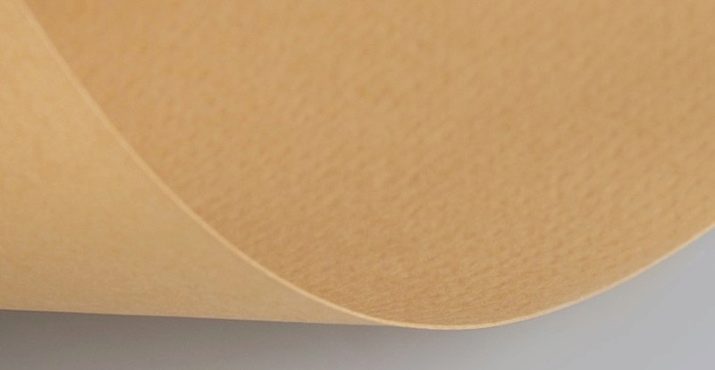
General principles
Each origami assembly technique allows you to make a variety of crafts that are not similar to each other, however, all techniques share certain conventions... These signs consist of certain symbols (arrows, dashes, lines, etc.), which, without unnecessary words, in an easy way explain what manipulations need to be done with a sheet of paper. A unique and simple system of signs was invented by the Japanese origami specialist - Akira Yoshizawa.

Folding figures with children
Many children enjoy folding origami figures, especially if they can be used for play or as a gift to a loved one. Paper crafts are a great way to make Christmas decorations for school or a March 8 gift for teachers and female relatives. Models can be made both from colored paper and from a notebook sheet or newspaper. The folding exercises are very rewarding - they develop fine motor skills and imagination.
We suggest considering some interesting ideas for creating origami with children.
-
Crafts for games. The origami technique allows you to fold different figures, which you can later play with. The most popular origami toys among children are the finger trap and the fortune teller. Flying planes are no less popular, which are often played not only by children, but also by adults. Crafts of animals and birds, for example, a lark, a mouse or a giraffe, are also suitable for games.



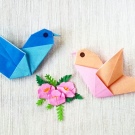


- Present... Every parent knows for sure that children's creativity is the best gift. Surely many people have their child's first "work of art" hanging on the refrigerator. With the help of origami technique, children can create really impressive things that can be gifted for different holidays. For example, a peony or a lily of the valley made of paper is a great gift for March 8, and a warship, a cannon or a model airplane is a chic gift for boys on February 23.




- Unusual figures. Children use many paper crafts to decorate rooms. A great decoration for a nursery is a paper Pokemon with sticker eyes, a kusudama ball or the famous crane. For girls, crafts for a dollhouse will be relevant, for example, furniture (sofa, table and chairs) or items of clothing (dresses, shoes or handbags). Boys will be interested in assembling small models of cars, trucks or boats.





A huge space for children's creativity is revealed by the modular origami "polyhedron", because there are many ways to make such a figure. The variety of such products is provided by several ways of folding the modules, the range of materials used and a large number of figures (for example, tetrahedron and dodecahedron). Craft "kusudama" is also considered a polyhedron and can have different shapes, for example, stars.



Ideas for adults
Origami is a fun and versatile art that has millions of fans around the world.... Currently, lovers of paper crafts organize special associations in which origamists gather to create new unusual paper models with their own hands.
The high prevalence led to the fact that art began to develop at a tremendous pace - now there are a large number of crafts for which instructions have not yet been written, because origami lovers often invent new figures.
Consider a few origami ideas for adults.
-
Maple Leaf... The craft consists of several parts. The sheet can be made monochromatic, creating modules of the same color, or saturate it with the colors of autumn, creating details from paper of different colors. These crafts can be used to decorate your home in the fall - they look great on windows and mirrors.

- Girl using wet origami technique. Figures of girls are an excellent decoration for a home or workplace, a neat model does not take up much space and amazes with its beauty. The most popular figurines are Violinist Girl, Little Red Riding Hood and Lady with Wings.



- Realistic rhino. There are many ways to assemble a rhinoceros from paper - from simple diagrams with few folds to complex three-dimensional models. Wet origami is considered to be the most difficult technique, but it reliably conveys the shape of this powerful beast. You can first try making a rhino using the classic sharp-fold technique, and then try your hand at creating a version of the animal with smooth outlines.


- Fur seal. Marine life is a great source of inspiration for origami lovers. Making a fur seal figurine is a great way to hone your folding skills and add to your collection of paper models.


- Diamond... A shiny diamond or diamond is a great DIY Christmas tree decoration. A pretty crystal is created in different ways - from one sheet in the classical technique and from modules of a certain shape.

- Train... Many people associate rail transport with travel and recreation, so origami lovers have come up with a way to make a three-dimensional model of an origami train to decorate their home.


Interesting Facts
Origami is an ancient art invented many years ago in eastern countries. Nevertheless, the very word "origami" was invented quite recently - in 1880, and before that paper figures were called "orikata", which is translated from Japanese as "folded figures".
Many historians believe that arts and crafts were invented in Japan, but there is no exact proof of this, because it has long been popular in other eastern countries such as China and Korea.
Initially, paper models were created to decorate rooms during holidays or for religious purposes, because in ancient times, paper was an expensive pleasure. In addition, the very technique of creating handicrafts was inherited and was considered a family value. According to Eastern traditions, origami manufacturing technology was passed on precisely through the female line - mothers revealed the secrets of assembly to their daughters.

The rich history of the origin and development of origami has preserved many interesting facts to our time. We propose to consider some of them.
-
The first book related to origami was published in 1797 by a Japanese named Akisato Rito. A book titled Sembazuku orikata (or Folding a Thousand Cranes) described cultural practices in Japan, including the creation of paper figurines.

- The greatest contribution to the development of art was made by Akira Yoshizawa, has published several teaching books with general folding principles and a wide variety of schemes.

- The largest paper crane was folded in 1999 - its height was 6.5 meters, and its weight reached 794 kg. Since then, origami "crane" has been considered an international symbol of peace.

- The tiniest crane was created by an origamist named Akira Naito. - to create the model, he used paper with a size of only 1x1 mm. To fold the miniature model, the craftsman used a microscope and tweezers.

- The Guinness Book of Records contains a huge number of records associated with the origami technique, - from the manufacture of the most complex models in the world to the high-speed assembly of certain figures.



For more on what origami is and how it happens, see the video below.








